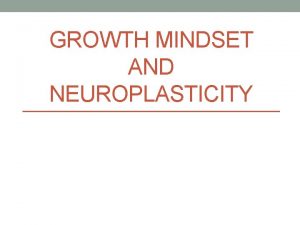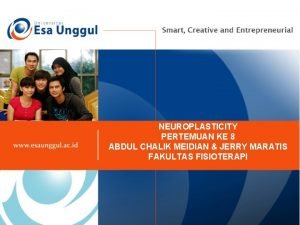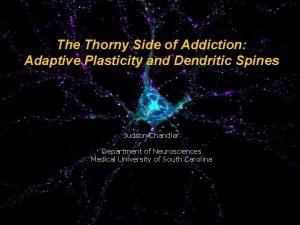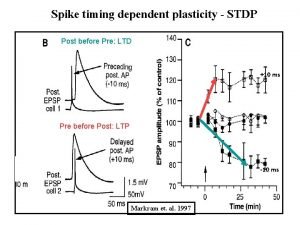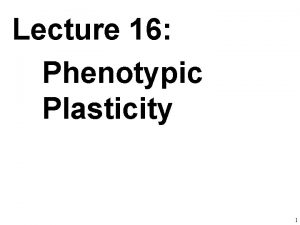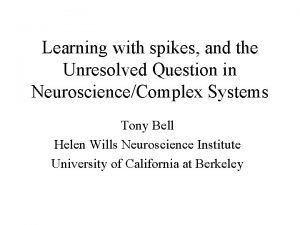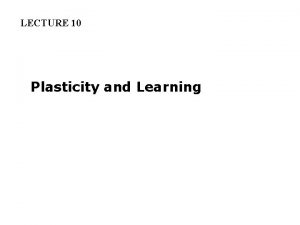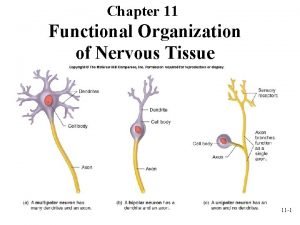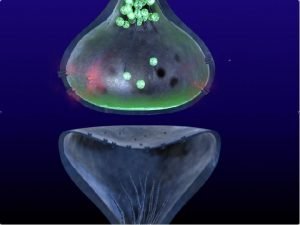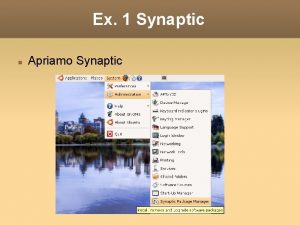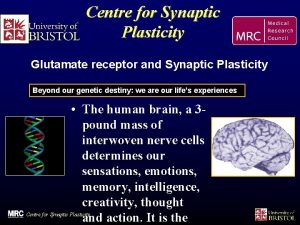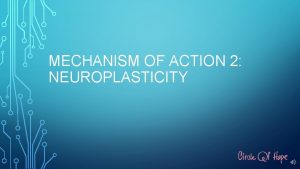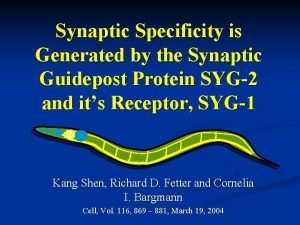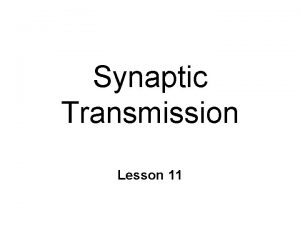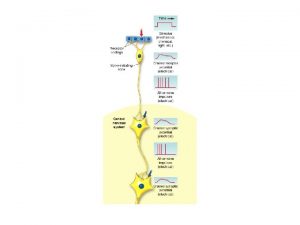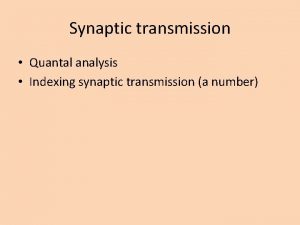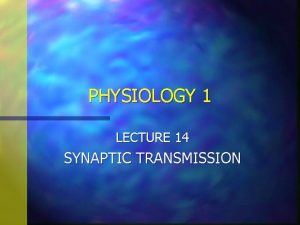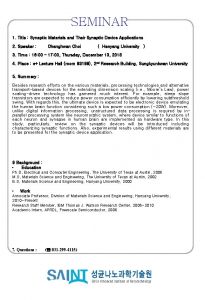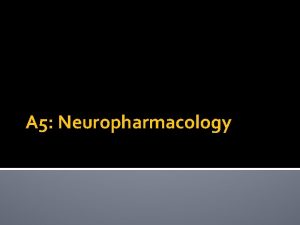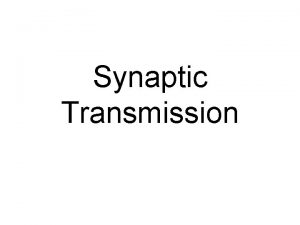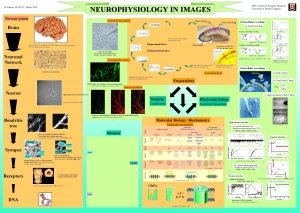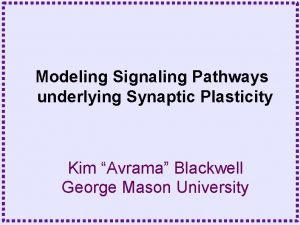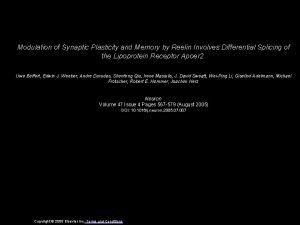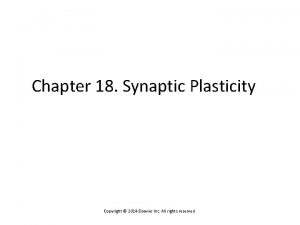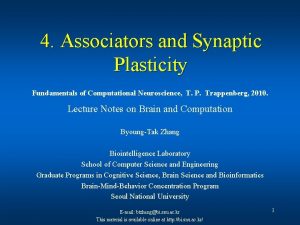Neuroplasticity Agenda 1 Synaptic Plasticity a Short term




















- Slides: 20

Neuroplasticity

Agenda 1. Synaptic Plasticity a) Short term b) Long term 2. Experience Dependent Plasticity and Regeneration 3. Implications for Practice

Synaptic Plasticity

Short term Plasticity Enhancement Persistent actions of Ca+ in presynaptic terminal (Ca+ hanging around longer) • Facilitation • Augmentation • Potentiation

Short term Plasticity Depression Activity dependent depletion synaptic vesicles So much activity that the concentration of Ca+ outside the neuron becomes less than that inside the neuron Decreases the amount of neurotransmitter that can be released

So why is this called plasticity? Plasticity= change= learning Habituation- use up all the neurotransmitters, soo. . . Sensitization- recruit other neurons to get involved

Short term Sensitization Serotonin> G-protein receptor>ATP>c. AMP> PKA> inhibit K+> increase Ca+ > release of glutamate

Long term Sensitization

Conclusions 1. Synaptic plasticity can lead to changes in circuit function and to behavior plasticity 2. Change in synaptic function can lead to change in gene expression, new protein synthesis, growth of new synapses

Principles for Learning (Hippocampus) • Neurons that fire together wire together (timing is important)* • If one neuron response is weak but firing is paired with a neuron with a stronger response, eventually they will both respond strongly. (association is important) • Neurons that are not activated during a stimulus will not be changed. (some activity is important) • Lack of synchronized firing may extinguish strength of synapse (practice is important) *Hebb’s postulate

Experience Dependent Plasticity and Neural Regeneration

Early Development • Basic network and # of neurons is set prior to birth, environment influences fine tune the network during critical periods pre- and post -natal (mediated by NMDA receptors) • Lack of input (or harmful input) during critical period may result in permanent damage • Synaptic pruning in grey matter starts around 12 y/o, along with growth of white matter • Lack of pruning implicated in Sz, ADHD, autism

(Gee, 2015)

Neural Regeneration • Peripheral nerve regeneration • Restoration of CNS damage • Genesis of new neurons (only in the hippocampus)

Barriers to CNS regeneration 1. 2. 3. 4. Local injury of brain tissue often leads to neuronal death. Glial cells actively inhibit axon growth and form scar tissue. Stem cells are constrained in ability to migrate and specialize. Immune response by microglia, astrocytes and oligodendrocytes release cytokines that inhibit extensive growth.

Implications for Practice

Motor Learning • Constraint induced therapy – forced use • Mirror therapy- observation of arm movement • Imitation of movement – activation of mirror neuron system • Virtual reality applications (Zhang, 2018)

Sensory Integration • Use of organized sensory input during critical periods • The type and amount of sensory input should be matched specifically to the child’s needs • Paired multi-sensory input may lead to facilitation or inhibition and onto integration (Lane, 2010)

Cognitive Rehabilitation • Errorless learning for best memory response • Problem solving for best metacognitive response • Make it meaningful • Provide a neural environment that promotes recovery: LOW STRESS • Repete instructions often and in exactly the same way • Routine! And consistent environmental cues

Gee, D. G. , & Casey, B. J. (2015). The impact of developmental timing for stress and recovery. Neurobiology of Stress, 1, 184 -194. doi: https: //doi. org/10. 1016/j. ynstr. 2015. 02. 001 Lane, S. J. , & Schaaf, R. C. (2010). Examining the neuroscience evidence for sensory-driven neuroplasticity: Implications for sensory-based occupational therapy for children and adolescents. American Journal of Occupational Therapy, 64, 375– 390. doi: 10. 5014/ajot. 2010. 09069 Zhang, J Kenneth N. K. Fong, Nandana Welage, and Karen P. Y. Liu, “The Activation of the Mirror Neuron System during Action Observation and Action Execution with Mirror Visual Feedback in Stroke: A Systematic Review, ” Neural Plasticity, vol. 2018, Article ID 2321045, 14 pages, 2018. https: //doi. org/10. 1155/2018/2321045.
 Tall+short h
Tall+short h What's my mindset
What's my mindset Neural networks ib psychology
Neural networks ib psychology Habituation neuroplasticity
Habituation neuroplasticity Adaptive plasticity
Adaptive plasticity Unto us spike milligan
Unto us spike milligan Arash ashari
Arash ashari Adaptive plasticity
Adaptive plasticity Stdp
Stdp Consistancy index
Consistancy index How thick is the earths crust
How thick is the earths crust Plasticity
Plasticity Earth asthenosphere
Earth asthenosphere Long term plan and short term plan
Long term plan and short term plan Long term memory vs short term memory
Long term memory vs short term memory Short term human resources examples
Short term human resources examples Difference between long term and short term liabilities
Difference between long term and short term liabilities Long-term liabilities examples
Long-term liabilities examples Short-term and long-term goals examples
Short-term and long-term goals examples Short term and long term cash forecasting
Short term and long term cash forecasting Postsynaptic potential
Postsynaptic potential

